Attached files
| file | filename |
|---|---|
| 8-K - FORM 8-K - METLIFE INC | d486796d8k.htm |
 Steven A. Kandarian
Chairman, President &
Chief Executive Officer
February 14, 2013
Bank of America Merrill Lynch
2013 Insurance Conference
Exhibit 99.1 |
 This presentation may contain or incorporate by reference forward-looking
statements. Forward-looking statements give expectations or forecasts of future events and
use words such as “anticipate,”
“estimate,”
“expect,”
“project”
and other terms of similar meaning. Any or all
forward-looking statements may turn out to be wrong, and
actual results could differ materially from those expressed or implied in the forward-looking statements.
Predictions of future performance are
inherently
difficult
and
are
subject
to
numerous
risks
and
uncertainties,
including
those
identified
in
the
“Risk
Factors”
section
of
MetLife,
Inc.’s
filings
with the U.S. Securities and Exchange Commission. The company does not
undertake any obligation to publicly correct or update any forward-looking statement if it
later becomes aware that such statement is not likely to be achieved.
Additional discussion of forward-looking statements may be included in other slides in this
presentation; if so, please refer to those slides for more information.
The presentation may also contain measures that are not calculated based on
accounting principles generally accepted in the United States of America, also known as
GAAP. Additional discussion of non-GAAP financial information may be
included in other slides in this presentation, on the Investor Relations portion of MetLife's
website
(www.metlife.com),
or elsewhere on that website; if so, please refer to those slides or the website
for more information. Cautionary Statement on Forward Looking Statements and
Non-GAAP Financial Information
2 |
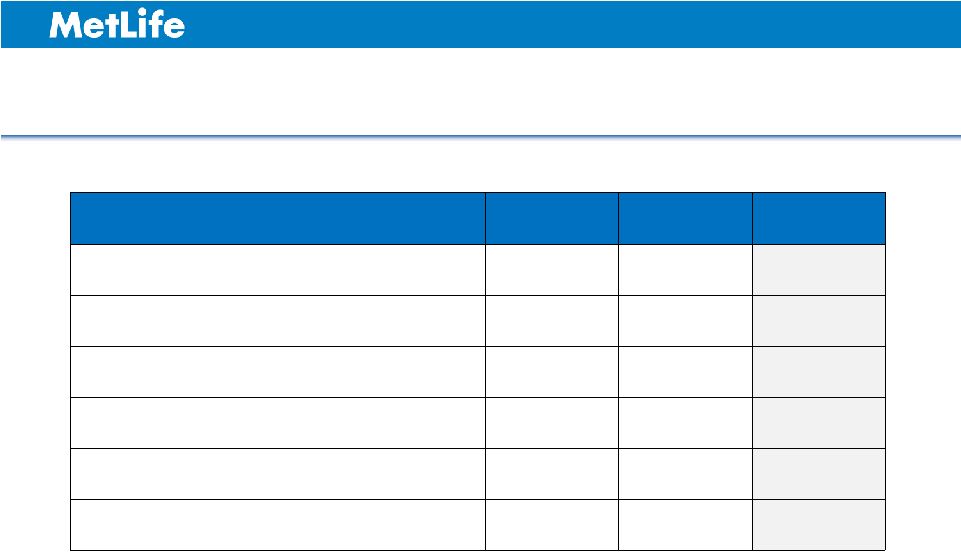 A
Strong Year in a Challenging Environment See Appendix for non-GAAP
financial information, definitions and/or reconciliations. ($ in millions,
except per share data) 2011
2012
Variance
Operating Earnings
$4,677
$5,686
22%
Operating Earnings Per Share
$4.38
$5.28
21%
Premiums, Fees & Other Revenues
$45,449
$47,879
5%
Operating Expense Ratio
24.4%
23.8%
(60) bps
Book Value per Share, excluding AOCI
$46.69
$46.73
-
Operating ROE
10.1%
11.3%
120 bps
3 |
 Strategy to Become a World-Class Company
Drive Toward
Customer Centricity
and a Global Brand
Grow
Emerging Markets
Build Global
Employee Benefits
Business
Refocus the U.S.
Business
GLOBAL
*
WORLD-CLASS
*
SCALE
4 |
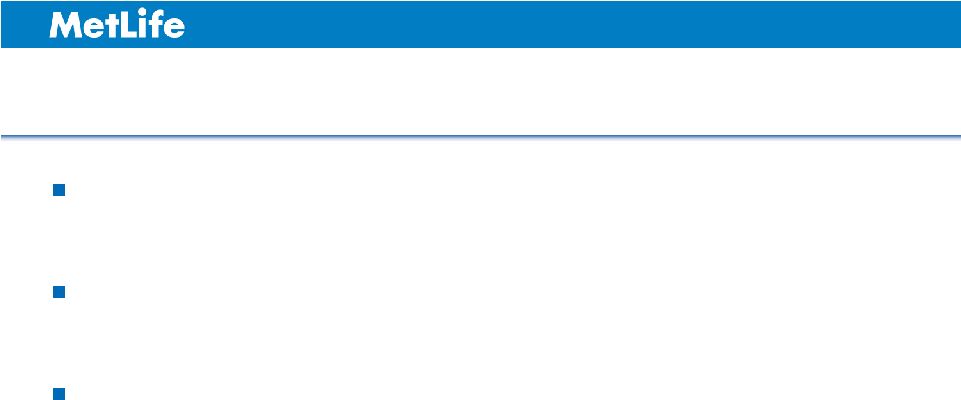 Refocus
the
U.S.
business
–
VA
strategy
Grow
emerging
markets
–
Provida
acquisition
Creating
shareholder
value
–
Increase
operating
ROE,
lower
cost
of
equity capital (COEC)
Executing on our Strategy
5
See Appendix for non-GAAP financial information, definitions and/or
reconciliations. |
 Managing for Another Material Drop in VA Sales
6
1
Statutory premiums, direct and assumed, excluding company sponsored internal
exchanges. 2
Represents midpoint of the guidance range of $10 to $11 billion.
($ in Billions)
MetLife U.S. Variable Annuity Sales¹
2
$15.3
$13.9
$15.4
$18.3
$28.4
$17.7
$10.5
2007
2008
2009
2010
2011
2012
2013P |
 Introduced new guaranteed minimum income benefit (GMIB) variable
annuity effective February 4, 2013
–
Reduced roll-up rate from 5.0% to 4.0%
–
Reduced withdrawal rate from range of 4.5%-5.0% to 4.0%
Products under consideration would further improve annuity risk profile
Competitive landscape has changed for VAs
Further Actions to Improve Annuity Risk/Return Profile
7 |
 More
Favorable Return on Investment for New VA Product 1
GMIB
MAX
IV
(5%
Rollup)
launched
on
Aug.
20,
2012
and
GMIB
Max
V
(4%
Rollup)
launched
on
Feb.
4,
2013.
The
pricing
results
were
based
on
market
conditions
as of December 31, 2012. Incidences of ROIs reflected in the chart above are the results of roughly 1,000 stochastic scenarios observed.
8
61%
75%
GMIB Max IV (5% Rollup)
GMIB Max V (4% Rollup)
>15%
12% to 15%
10% to 12%
8% to 10%
0% to 8%
<0%
Distribution
of
Potential
Return
Scenarios
1 |
 Refocus
the
U.S.
business
–
VA
strategy
Grow
emerging
markets
–
Provida
acquisition
Creating
shareholder
value
–
Increase
operating
ROE,
lower
cost
of
equity capital (COEC)
Executing on our Strategy
9
See Appendix for non-GAAP financial information, definitions and/or
reconciliations. |
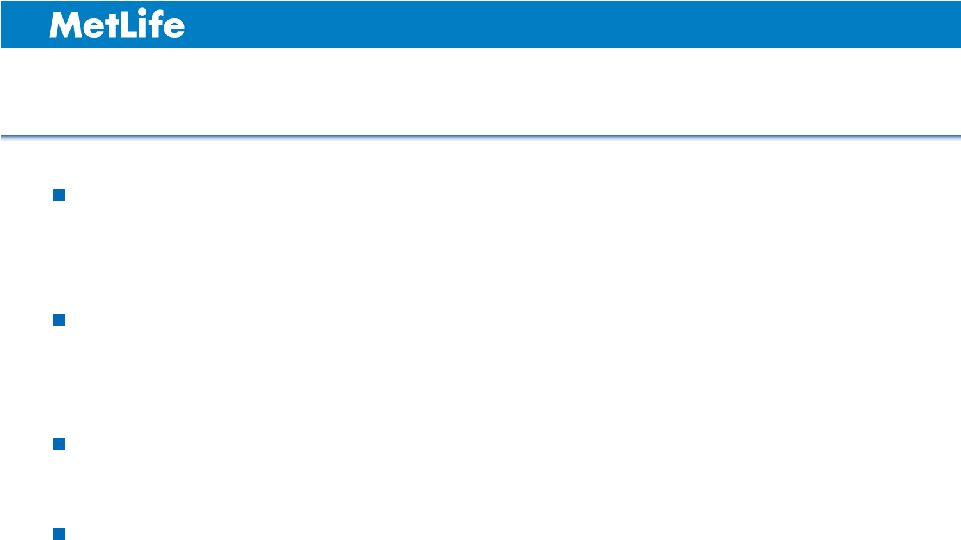 Acquiring AFP Provida for approximately $2 billion in cash, funded with
on balance sheet resources
Price is approximately 10x forward earnings expectation, expect
operating
EPS
accretion
of
approximately
$0.05
in
2013,
$0.15
in
2014
Acquisition creates value assuming 75% equity, 25% debt funding mix
Free cash flow generation for acquired business expected to be
roughly 70% of operating earnings
Provida Acquisition a Positive for Shareholder Value
10
See Appendix for non-GAAP financial information, definitions and/or
reconciliations. |
 Provida: A Growth Opportunity in an Attractive Market
Highest
rated
country
in
region
1
,
government
surplus
position
5-year
projected
GDP
growth
rate
of
4.7%
2
Provida
ranked
#1
(29%
market
share)
in
concentrated
market
3
Employees required to contribute fixed percentage of salaries
Chile
Economics of the
Pension Business
AFP Market
11
1
Sovereign debt ratings of A+/A+/Aa3 (S&P/Moody’s/Fitch).
2
Economic
Intelligence
Unit
for
the
period
2013
–
2017.
3
Company filings and FactSet. Note: Local currency figures converted at spot rate of
$471.1 CLP/USD as of January 22, 2013. Figure denotes rank and market share by
mandatory AUM.
Fees charged as a percentage of contributions, not AUM
Strong and predictable free cash flows |
 Provida Deal Aligns with Strategic Goals
1
Based
on
5-year
projected
average
PGAAP
ROE
assuming
75%
equity
/
25%
debt
capital
structure.
See Appendix for non-GAAP financial information, definitions and/or
reconciliations. Pre-Tax Expense Savings
12
Grow Emerging Markets to 20%+ of
Operating Earnings
Shift from Market Sensitive to Protection
Products
Operating ROE Expansion
~15%
(1)
Levered
Operating ROE
Fees Based on
Contributions
14% 17% |
 Refocus
the
U.S.
business
–
VA
strategy
Grow
emerging
markets
–
Provida
acquisition
Creating
shareholder
value
–
Increase
operating
ROE,
lower
cost
of
equity capital (COEC)
Executing on our Strategy
13
See Appendix for non-GAAP financial information, definitions and/or
reconciliations. |
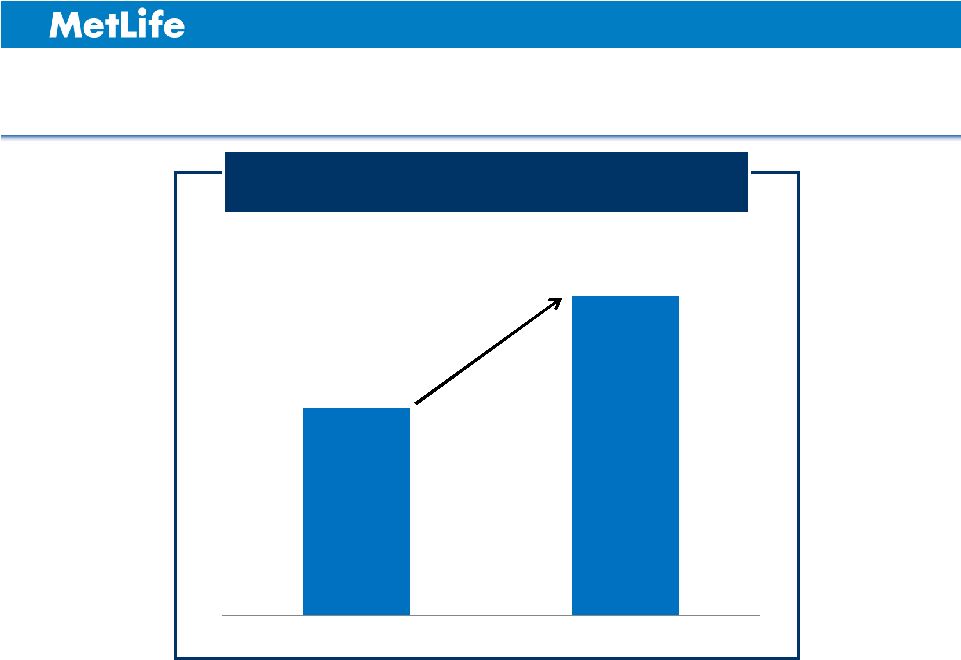 Goal is to Expand Operating ROE
Expect to Achieve 12% Operating ROE by 2016
Even if Interest Rates Remain Low
1
14
1
The bars represent mid-points of ranges.
See Appendix for non-GAAP financial information, definitions and/or
reconciliations. 12.0% -
14.0%
10.2% -
10.9%
2013P
2016 Target |
 MetLife Operating ROE Spread to Cost of Equity Capital
15
Sources: BofA Merrill Lynch and Professor Aswath Damodaran, Stern School of
Business (NYU). See Appendix for non-GAAP financial information,
definitions and/or reconciliations. -12%
-10%
-8%
-6%
-4%
-2%
0%
2%
4%
6%
8%
2001
2002
2003
2004
2005
2006
2007
2008
2009
2010
2011
2012 |
 Working on Both Sides of Value Creation
Valuation is a function of both return on equity and cost of equity
capital
We are committed to increase operating ROE and decrease COEC
over time
We believe our VA strategy and the Provida acquisition lower COEC
and increase operating ROE
16
See Appendix for non-GAAP financial information, definitions and/or
reconciliations. |
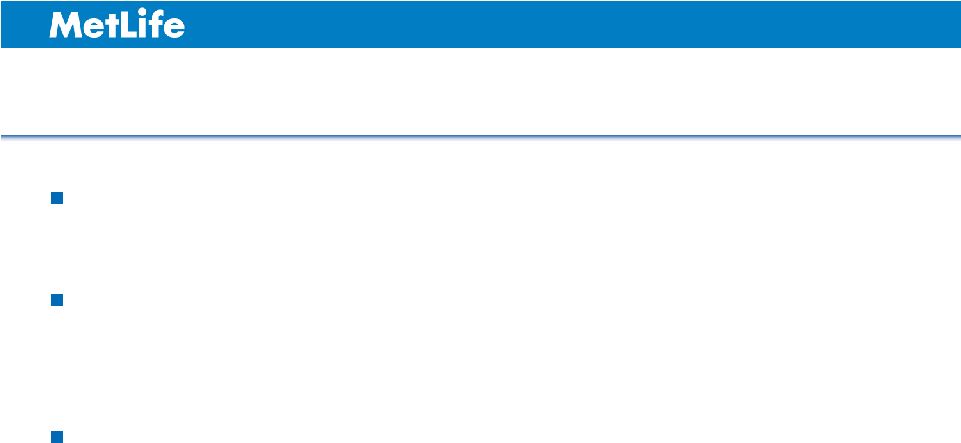 Key
Takeaways Strong financial performance in 2012
Continue to execute on strategic initiatives despite macro and
regulatory uncertainty
Improving operating ROE and lowering cost of equity capital should
drive shareholder value over time
17
See Appendix for non-GAAP financial information, definitions and/or
reconciliations. |
 |
 Appendix
2 0 1 3
INSURANCE CONFERENCE |
 Safe Harbor Statement
20
These materials may contain or incorporate by reference information that includes or is based upon
forward-looking statements within the meaning of the Private Securities Litigation Reform
Act of 1995. Forward-looking statements give expectations or forecasts of future events. These statements can be identified by the fact that they do not relate strictly to
historical or current facts. They use words such as “anticipate,” “estimate,”
“expect,” “project,” “intend,” “plan,” “believe” and other words and terms of similar meaning in connection
with a discussion of future operating or financial performance. In particular, these include
statements relating to future actions, prospective services or products, future performance or
results of current and anticipated services or products, sales efforts, expenses, the outcome of
contingencies such as legal proceedings, trends in operations and financial results.
Any or all forward-looking statements may turn out to be wrong. They can be affected by inaccurate
assumptions or by known or unknown risks and uncertainties. Many such factors will be important
in determining the actual future results of MetLife, Inc., its subsidiaries and affiliates. These statements are based on current expectations and the current economic
environment. They involve a number of risks and uncertainties that are difficult to predict. These
statements are not guarantees of future performance. Actual results could differ materially
from those expressed or implied in the forward-looking statements. Risks, uncertainties, and other factors that might cause such differences include the risks, uncertainties
and other factors identified in MetLife, Inc.’s filings with the U.S. Securities and Exchange
Commission (the “SEC”). These factors include: (1) difficult conditions in the global capital
markets; (2) concerns over U.S. fiscal policy and the “fiscal cliff” in the U.S., as well as
rating agency downgrades of U.S. Treasury securities; (3) uncertainty about the effectiveness of
governmental and regulatory actions to stabilize the financial system, the imposition of fees relating
thereto, or the promulgation of additional regulations; (4) increased volatility and disruption
of the capital and credit markets, which may affect our ability to seek financing or access our credit facilities; (5) impact of comprehensive financial services regulation reform
on us; (6) economic, political, legal, currency and other risks relating to our international
operations, including with respect to fluctuations of exchange rates; (7) exposure to financial
and capital market risk, including as a result of the disruption in Europe and possible withdrawal of
one or more countries from the Euro zone; (8) changes in general economic conditions, including
the performance of financial markets and interest rates, which may affect our ability to raise capital, generate fee income and market-related revenue and finance
statutory reserve requirements and may require us to pledge collateral or make payments related to
declines in value of specified assets; (9) potential liquidity and other risks resulting from
our participation in a securities lending program and other transactions; (10) investment losses and defaults, and changes to investment valuations; (11) impairments of goodwill
and realized losses or market value impairments to illiquid assets; (12) defaults on our mortgage
loans; (13) the defaults or deteriorating credit of other financial institutions that could
adversely affect us; (14) our ability to address unforeseen liabilities, asset impairments, or rating
actions arising from acquisitions or dispositions, including our acquisition of American Life
Insurance Company and Delaware American Life Insurance Company (collectively, “ALICO”) and to successfully integrate and manage the growth of acquired businesses with
minimal disruption; (15) uncertainty with respect to the outcome of the closing agreement entered into
with the United States Internal Revenue Service in connection with the acquisition of ALICO;
(16) the dilutive impact on our stockholders resulting from the settlement of common equity units issued in connection with the acquisition of ALICO or otherwise;
(17) regulatory and other restrictions affecting MetLife, Inc.’s ability to pay dividends and
repurchase common stock; (18) MetLife, Inc.’s primary reliance, as a holding company, on
dividends from its subsidiaries to meet debt payment obligations and the applicable regulatory
restrictions on the ability of the subsidiaries to pay such dividends; (19) downgrades in our
claims paying ability, financial strength or credit ratings; (20) ineffectiveness of risk management policies and procedures; (21) availability and effectiveness of reinsurance or
indemnification arrangements, as well as default or failure of counterparties to perform; (22)
discrepancies between actual claims experience and assumptions used in setting prices for our
products and establishing the liabilities for our obligations for future policy benefits and claims; (23) catastrophe losses; (24) heightened competition, including with respect to
pricing, entry of new competitors, consolidation of distributors, the development of new products by
new and existing competitors, distribution of amounts available under U.S. government programs,
and for personnel; (25) unanticipated changes in industry trends; (26) changes in assumptions related to investment valuations, deferred policy acquisition
costs, deferred sales inducements, value of business acquired or goodwill; (27) changes in accounting
standards, practices and/or policies; (28) increased expenses relating to pension and
postretirement benefit plans, as well as health care and other employee benefits; (29) exposure to losses related to variable annuity guarantee benefits, |
 Safe Harbor Statement (Continued)
21
including from significant and sustained downturns or extreme volatility in equity markets, reduced
interest rates, unanticipated policyholder behavior, mortality or longevity, and the adjustment
for nonperformance risk; (30) deterioration in the experience of the “closed block” established in connection with the
reorganization of Metropolitan Life Insurance Company; (31) adverse results or other consequences from
litigation, arbitration or regulatory investigations; (32) inability to protect our
intellectual property rights or claims of infringement of the intellectual property rights of others; (33) discrepancies between actual
experience and assumptions used in establishing liabilities related to other contingencies or
obligations; (34) regulatory, legislative or tax changes relating to our insurance, banking,
international, or other operations that may affect the cost of, or demand for, our products or services, or increase the cost or
administrative burdens of providing benefits to employees; (35) the effects of business disruption or
economic contraction due to disasters such as terrorist attacks, cyberattacks, other
hostilities, or natural catastrophes, including any related impact on our disaster recovery systems, cyber- or other information
security systems and management continuity planning; (36) the effectiveness of our programs and
practices in avoiding giving our associates incentives to take excessive risks; and (37) other
risks and uncertainties described from time to time in MetLife, Inc.’s filings with the SEC.
MetLife, Inc. does not undertake any obligation to publicly correct or update any forward-looking
statement if MetLife, Inc. later becomes aware that such statement is not likely to be
achieved. Please consult any further disclosures MetLife, Inc. makes on related subjects in reports to the SEC.
|
 Explanatory Note on Non-GAAP Financial Information
Any references in this presentation (except in this Explanatory Note on
Non-GAAP Financial Information slide and the Appendix) to net income
(loss), net income (loss) per share, operating earnings, operating earnings per
share, book value per common share, premiums, fees and other revenues and
operating return on equity, should be read as net income (loss) available to MetLife, Inc.'s common shareholders, net income
(loss) available to MetLife, Inc.'s common shareholders per diluted common share,
operating earnings available to common shareholders, operating
earnings
available
to
common
shareholders
per
diluted
common
share,
book
value
per
common
share,
excluding
accumulated
other
comprehensive income (loss) ("AOCI"), premiums, fees and other revenues
(operating) and operating return on MetLife, Inc.’s common equity,
excluding AOCI, respectively.
Operating
earnings
is
the
measure
of
segment
profit
or
loss
that
MetLife
uses
to
evaluate
segment
performance
and
allocate
resources.
Consistent with accounting principles generally accepted in the United States of
America ("GAAP") accounting guidance for segment reporting,
operating
earnings
is
MetLife's
measure
of
segment
performance.
Operating
earnings
is
also
a
measure
by
which
MetLife
senior
management's and many other employees' performance is evaluated for the purposes of
determining their compensation under applicable compensation plans.
Operating earnings is defined as operating revenues less operating expenses, both
net of income tax. Operating earnings available to common shareholders
is defined as operating earnings less preferred stock dividends.
Operating
revenues
and
operating
expenses
exclude
results
of
discontinued
operations
and
other
businesses
that
have
been
or
will
be
sold
or
exited by MetLife, Inc. (“Divested Businesses”). Operating revenues
also excludes net investment gains (losses) (“NIGL”) and net derivative
gains (losses) (“NDGL”). Operating expenses also excludes goodwill
impairments. The following additional adjustments are made to GAAP revenues,
in the line items indicated, in calculating operating revenues: •
Universal life and investment-type product policy fees excludes the
amortization of unearned revenue related to NIGL and NDGL and certain
variable annuity guaranteed minimum income benefits ("GMIB") fees
("GMIB Fees"); •
Net investment income: (i) includes amounts for scheduled periodic settlement
payments and amortization of premium on derivatives that are hedges of
investments but do not qualify for hedge accounting treatment, (ii) includes income from discontinued real estate operations,
(iii) excludes post-tax operating earnings adjustments relating to insurance
joint ventures accounted for under the equity method, (iv) excludes certain
amounts related to contractholder-directed unit-linked investments, and (v) excludes certain amounts related to
securitization entities that are variable interest entities ("VIEs")
consolidated under GAAP; and •
Other revenues are adjusted for settlements of foreign currency earnings hedges.
22 |
 Explanatory Note on Non-GAAP Financial Information
(Continued)
23
The following additional adjustments are made to GAAP expenses, in the line items indicated, in
calculating operating expenses:
•
Policyholder benefits and claims and policyholder dividends excludes: (i) changes in the policyholder
dividend obligation related to NIGL and NDGL, (ii) inflation-indexed benefit adjustments
associated with contracts backed by inflation-indexed investments and amounts associated
with periodic crediting rate adjustments based on the total return of a contractually referenced pool
of assets, (iii) benefits and hedging costs related to GMIBs ("GMIB Costs"), and (iv)
market value adjustments associated with surrenders or terminations of contracts ("Market Value
Adjustments");
•
Interest credited to policyholder account balances includes adjustments for scheduled periodic
settlement payments and amortization of premium on derivatives that are hedges of policyholder
account balances but do not qualify for hedge accounting treatment and excludes amounts related
to net investment income earned on contractholder-directed unit-linked investments;
•
Amortization of deferred policy acquisition costs (“DAC”) and value of business acquired
("VOBA") excludes amounts related to: (i) NIGL and NDGL, (ii) GMIB Fees and GMIB Costs,
and (iii) Market Value Adjustments;
•
Amortization of negative VOBA excludes amounts related to Market Value Adjustments; •
Interest expense on debt excludes certain amounts related to securitization entities that are VIEs
consolidated under GAAP; and
•
Other expenses excludes costs related to: (i) noncontrolling interests, (ii) implementation of new
insurance regulatory requirements, and (iii) acquisition and integration costs. Operating return on MetLife, Inc.'s common equity is defined as operating earnings available to common
shareholders divided by average GAAP common equity. Operating expense
ratio is calculated by dividing operating expenses (other expenses net of capitalization of DAC) by premiums, fees and other
revenues (operating).
MetLife believes the presentation of operating earnings and operating earnings available
to common shareholders as MetLife measures it for management purposes enhances the
understanding of the company's performance by highlighting the results of operations and the underlying
profitability drivers of the business. Operating revenues, operating expenses, operating
earnings, operating earnings available to common shareholders, operating earnings available to
common shareholders per diluted common share, book value per common share, excluding AOCI, book
value per diluted common share, excluding AOCI, operating return on MetLife, Inc.’s common equity, operating return on MetLife, Inc.’s
common equity, excluding AOCI, investment portfolio gains (losses) and derivative gains (losses)
should not be viewed as substitutes for the following financial measures calculated in
accordance with GAAP: GAAP revenues, GAAP expenses, GAAP income (loss) from continuing
operations, net of income tax, GAAP net income (loss) available to MetLife, Inc.'s common
shareholders, GAAP net income (loss) available to MetLife, Inc.'s common shareholders per
diluted common share, book value per common share, book value per diluted common share, return on
MetLife, Inc.’s common equity, return on MetLife, Inc.’s common equity, excluding AOCI, net
investment gains (losses) and net derivative gains (losses), respectively. |
 Explanatory Note on Non-GAAP Financial Information
(Continued)
24
For the historical periods presented, reconciliations of non-GAAP measures used in this
presentation to the most directly comparable GAAP measures may be included in an Appendix to
the presentation materials and/or are on the Investor Relations portion of our Internet website.
Additional information about our historical results is also available on our Internet website in our
Quarterly Financial Supplements for the corresponding periods. Managed Assets (as
defined below) is a financial measure based on methodologies other than GAAP. MetLife utilizes “Managed Assets” to
describe assets in its investment portfolio which are actively managed and reflected at estimated fair
value. MetLife believes the use of Managed Assets enhances the understanding and
comparability of its investment portfolio by excluding assets such as policy loans, other invested assets,
mortgage loans held-for-sale, and mortgage loans held by consolidated securitization entities,
as substantially all of those assets are not actively managed in MetLife’s investment
portfolio. Trading and other securities are also excluded as this amount is primarily comprised of contractholder-
directed unit-linked investments, where the contractholder, and not the company, directs the
investment of these funds. Mortgage loans and certain real estate investments have also been
adjusted from carrying value to estimated fair value.
The non-GAAP measures used in this presentation should not be viewed as substitutes for the most
directly comparable GAAP measures.
In this presentation, we may refer to sales activity for various products. These sales statistics do
not correspond to revenues under GAAP, but are used as relevant measures of business
activity.
The impact of changes in foreign currency exchange rates is calculated using the average foreign
currency exchange rates for the current period and is applied to the prior period. In this
presentation, we may provide guidance on our future earnings, premiums, fees and other revenues, earnings per diluted common share,
book value per common share and return on common equity on an operating or non-GAAP
basis. A reconciliation of the non-GAAP measures to the most directly comparable GAAP
measures is not accessible on a forward-looking basis because we believe it is not possible to provide other
than a range of net investment gains and losses and net derivative gains and losses, which can
fluctuate significantly within or without the range and from period to period and may have a
significant impact on GAAP net income. |
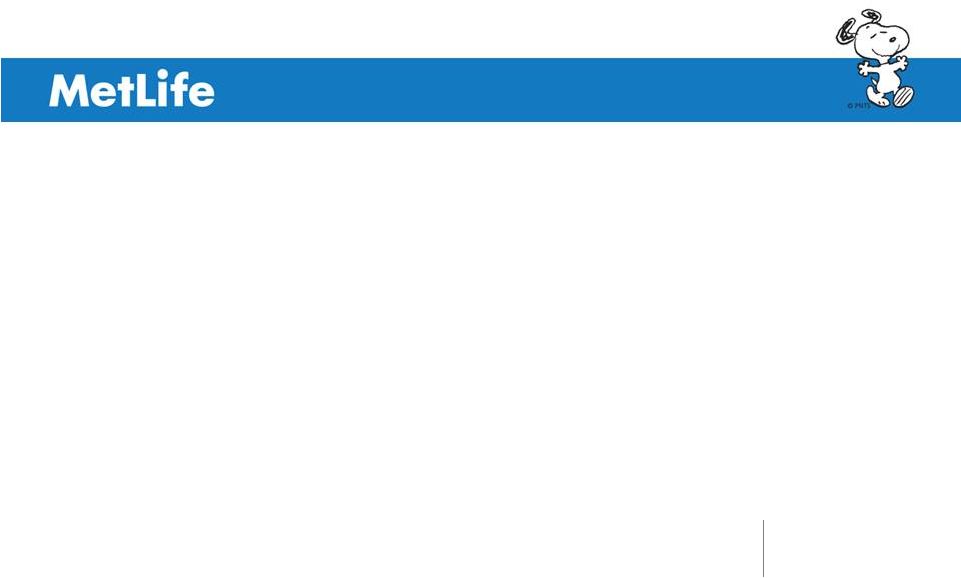 Reconciliations
2 0 1 3
INSURANCE CONFERENCE |
 Reconciliation of Operating Earnings Available to Common Shareholders to
Income (Loss) from Continuing Operations, Net of Income Tax
26
(In millions, except per share data)
Operating earnings available to common shareholders
5,686
$
$ 5.28
4,677
$
$ 4.38
Add: Preferred stock dividends
122
0.11
122
0.11
Operating earnings
$ 5,808
$ 5.39
$ 4,799
$ 4.49
Adjustments from operating earnings to income (loss) from continuing operations,
net of income tax: Add: Net investment gains (losses)
(352)
(0.33)
(867)
(0.81)
Add: Net derivative gains (losses)
(1,919)
(1.78)
4,824
4.52
Add: Goodwill impairment
(1,868)
(1.73)
-
-
Add: Other adjustments to continuing operations
(2,550)
(2.37)
(1,451)
(1.36)
Add: Provision for income tax (expense) benefit
2,195
2.04
(914)
(0.86)
Income (loss) from continuing operations, net of income tax
1,314
$
1.22
$
6,391
$
5.98
$
Weighted average
common
shares
outstanding
-
diluted
1,076.8
1,068.1
2012
2011 |
 Reconciliation
of
Premiums,
Fees
&
Other
Revenues
(Operating)
to
Premiums,
Fees
&
Other Revenues (GAAP)
(In millions)
2012
2011
Premiums, fees & other revenues (operating)
47,879
$
45,449
$
Adjustments from premiums, fees & other revenues (operating) to
premiums, fees & other revenues (GAAP):
Add: Premiums
64
92
Add: Universal life and investment-type product policy fees
344
278
Add: Other revenues
150
880
Premiums, fees & other revenues (GAAP)
48,437
$
46,699
$
27 |
 Reconciliation of Return on Common Equity
2012
2011
Return on MetLife, Inc.'s Common Equity
Operating return on MetLife, Inc.'s common equity, excluding AOCI (1)
11.3%
10.1%
Operating return on MetLife, Inc.'s common equity (1)
9.6%
9.3%
Return on MetLife, Inc.'s common equity, excluding AOCI (2)
2.4%
13.2%
Return on MetLife, Inc.'s common equity (2)
2.0%
12.2%
Book Value Per Common Share (3)
Book value per common share, excluding accumulated other comprehensive
income (loss) - (actual common shares outstanding)
46.73
$
46.69
$
10.44
5.74
Book value per common share - (actual common shares outstanding)
57.17
$
52.43
$
Common shares outstanding, end of period (in millions)
1,091.7
1,058.0
(1) Operating return on MetLife, Inc.'s common equity is defined as operating earnings available
to common shareholders divided by average GAAP common equity. (2) Return on MetLife, Inc.'s
common equity is defined as net income available to common shareholders divided by average GAAP common equity.
(3) Book value per common share, book value per common share, excluding accumulated other
comprehensive income (loss) and MetLife, Inc.'s common equity exclude $2,043 million of equity.
Add: Accumulated other comprehensive income (loss) per common share
28 |
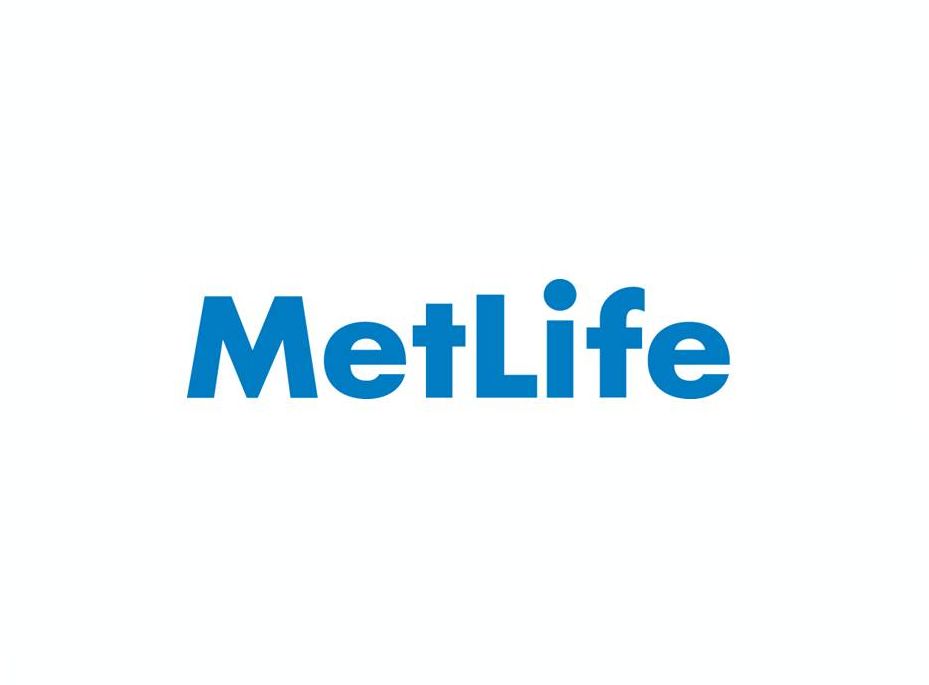 |
